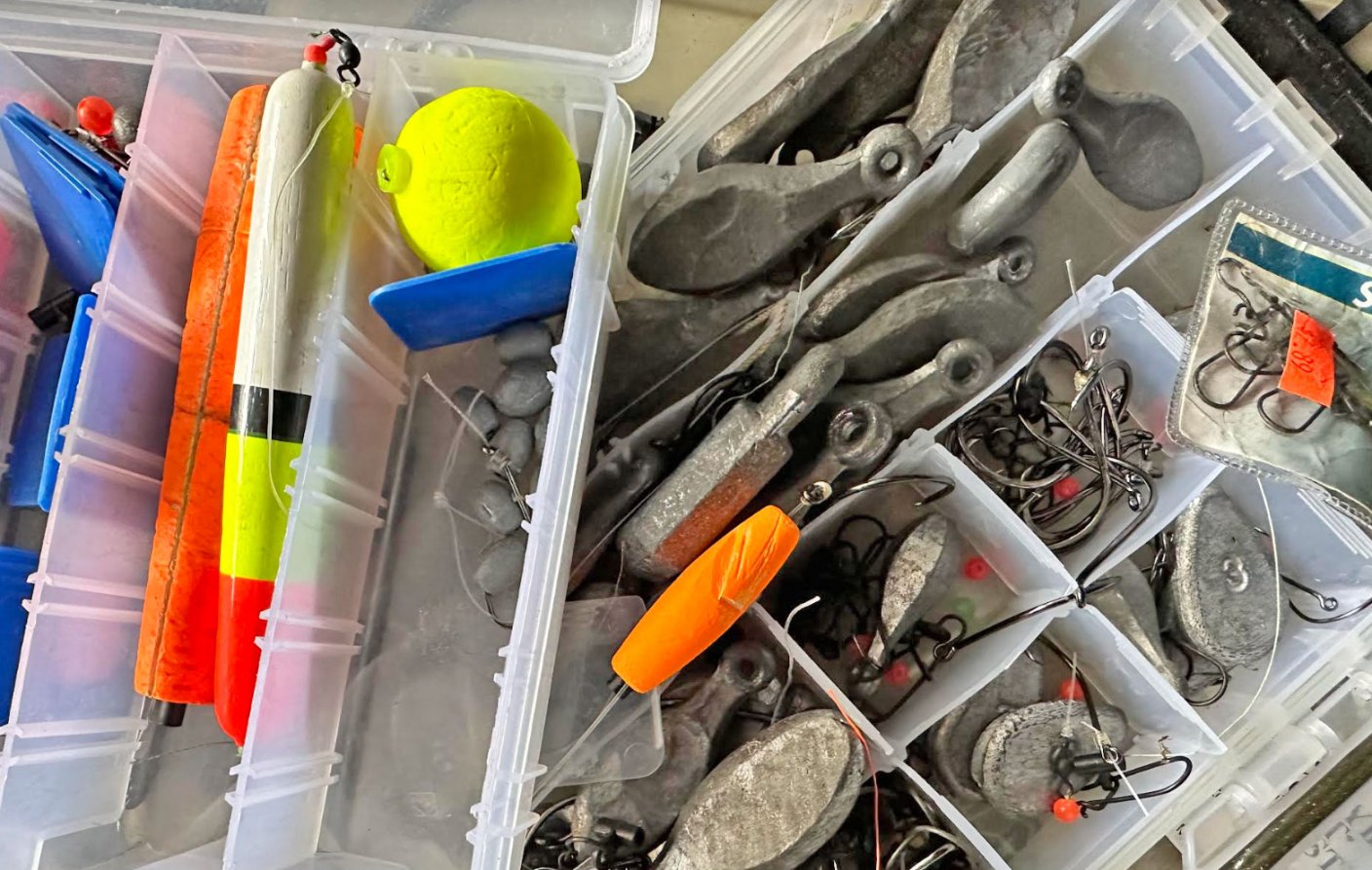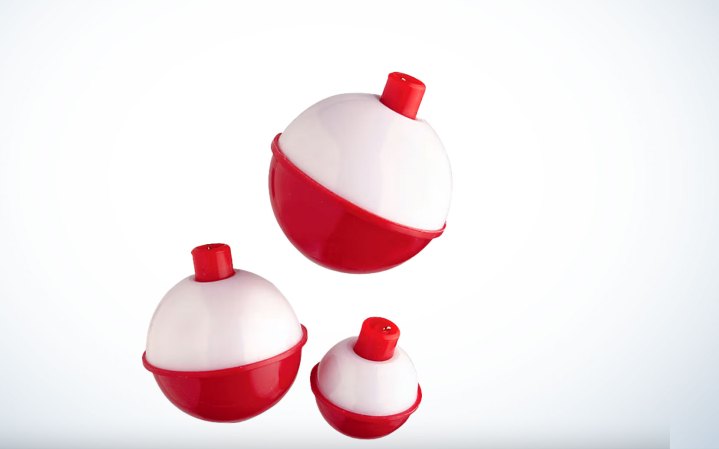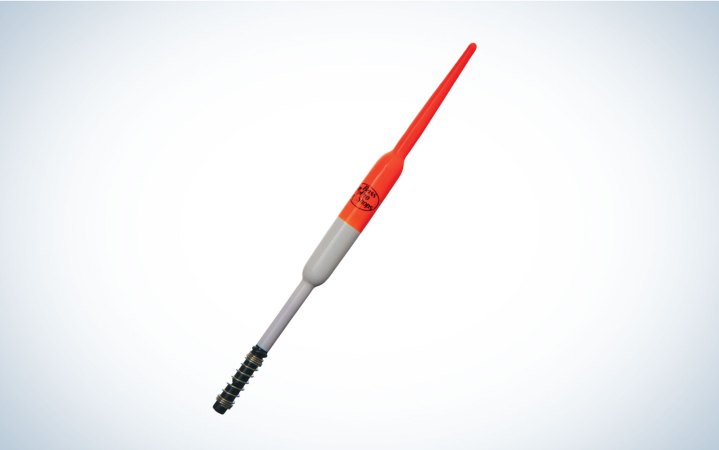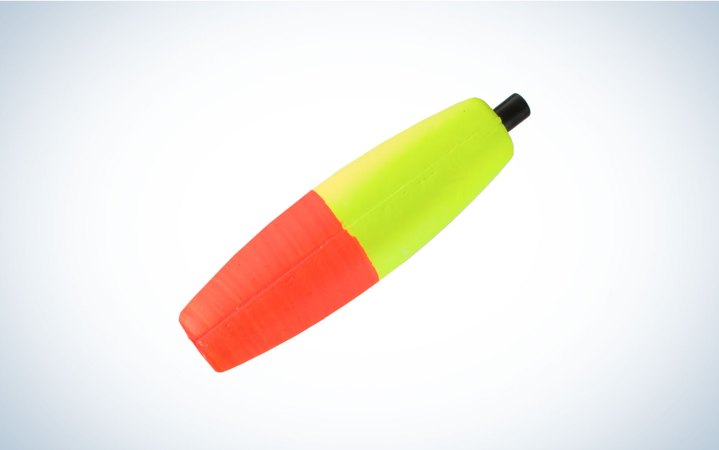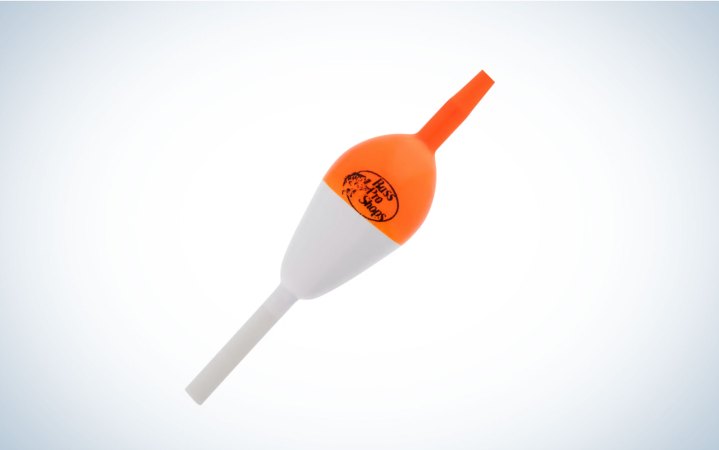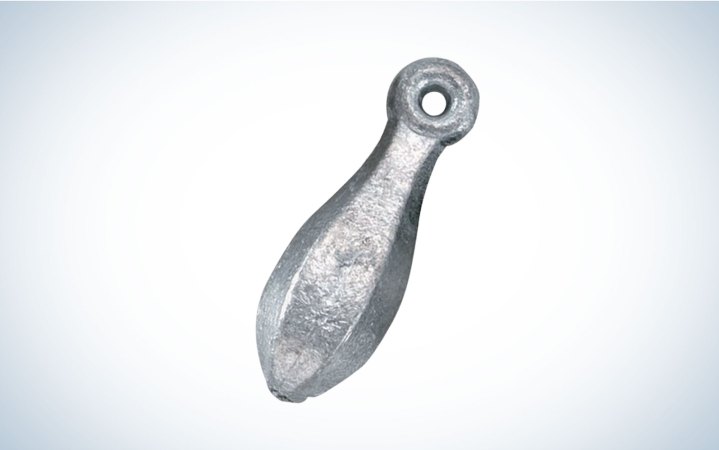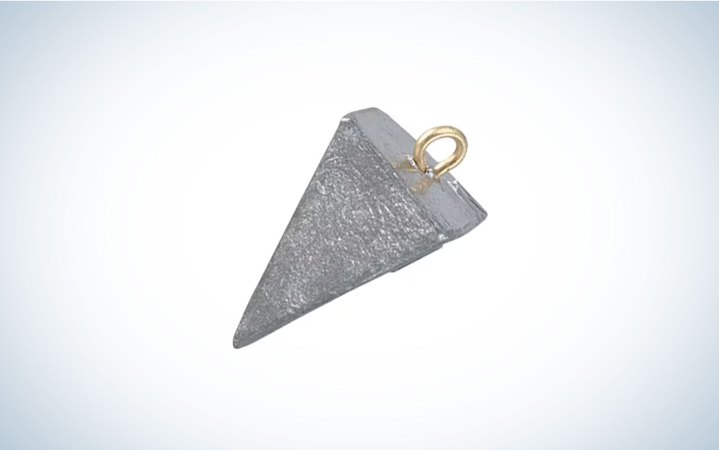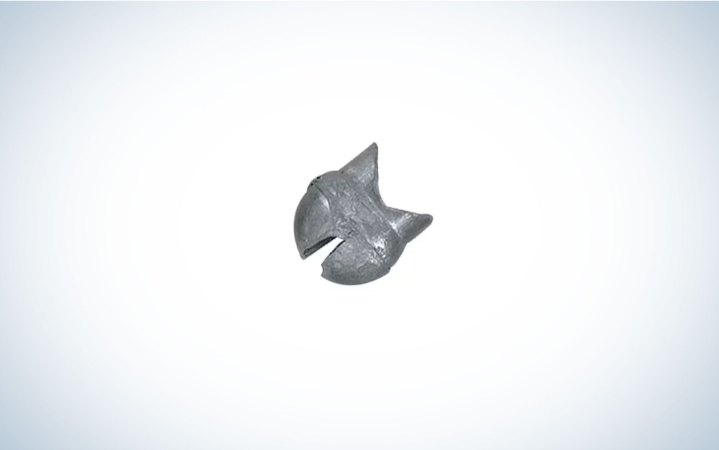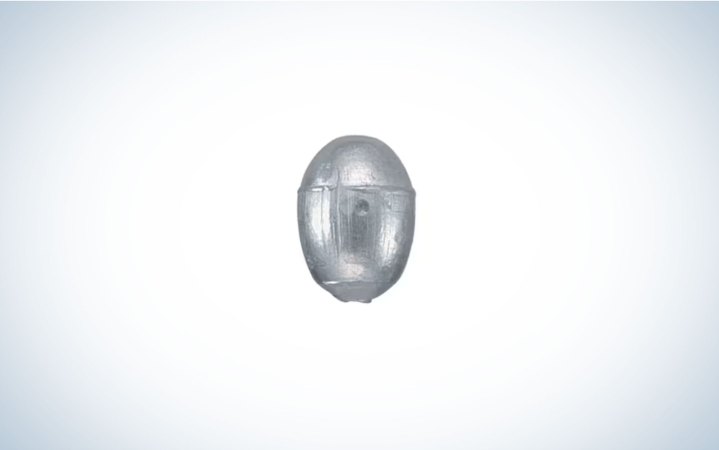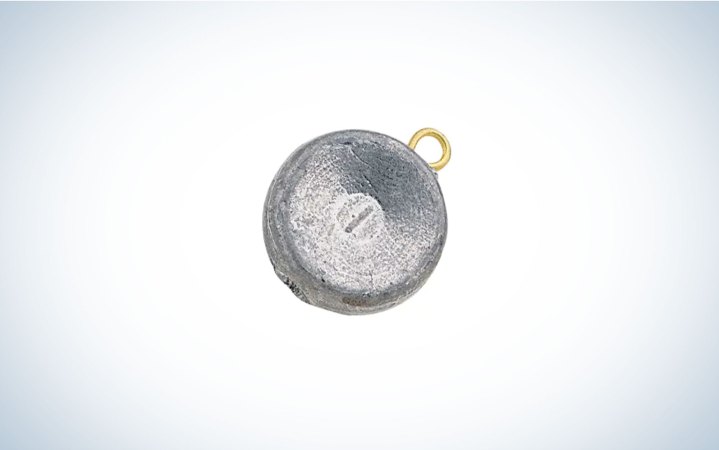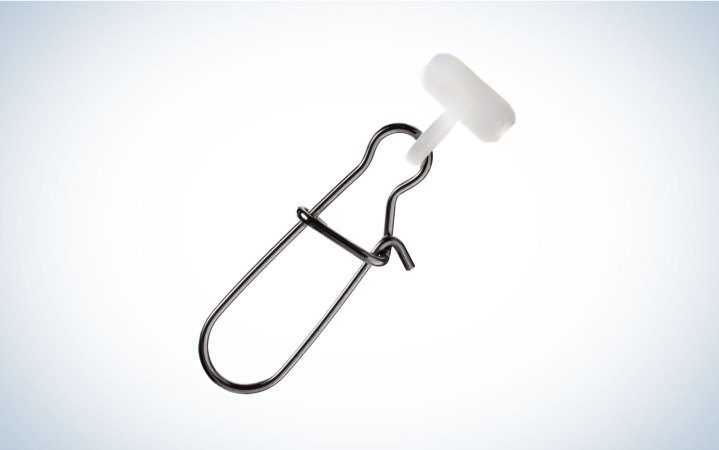We may earn revenue from the products available on this page and participate in affiliate programs. Learn More ›
A hook, line, rod, and reel. Those four components are the minimum gear requirements for catching a fish. Unfortunately, it gets a lot more complicated than that. While the bare essentials might get you by in many situations, you have to sweat the small stuff to really up your game. Lures and baits get a lot of attention, but terminal tackle often gets left by the wayside when it comes to instruction and tutorials. This is a mistake.
So what is terminal tackle? In short terminal tackle is the gear at the end of your line that gets cast out with your bait (sinkers, swivels, bobbers, etc.) and selecting the right terminal tackle can often mean the difference between success and failure.
These pieces of kit aren’t nearly as fun or exciting as choosing the perfect color jerkbait or learning how to dig your own worms, but it’s fair to say having the right terminal tackle can be far more critical to success than what’s on the end of your line. Compiled here is a breakdown of the most popular terminal tackle in fishing. At a surface level, most of it is very simple to comprehend, but by drilling down on how it works, how and why shapes and sizes vary, and when to put it into play, you’ll make smarter decisions at the tackle shop and catch more fish on the water.
Read Next: How to Choose the Right Fishing Hook
What Does a Barrel Swivel Do?
Barrel swivels are manufactured in a vast array of sizes and breaking strengths to accommodate any target you’re chasing. Comprising two eyelets joined to a barrel-shaped body, these swivels serve dual purposes, though their main function is reducing line twist. Each eyelet can rotate a full 360 degrees independently. That means if the current is making your piece of cut bait spin, or you’re using a lure with erratic action, a barrel swivel above your bait or lure will stop twist from traveling up your main line. Barrel swivels also create two very strong tie-in points, providing more peace of mind than when connecting your main line and leader via a splice knot.
What is a 3-Way Swivel For?
A 3-way swivel provides three tie-in eyelets that rotate independently on posts. They’re used most often for creating bait rigs. Your main line is tied to one eyelet, while a leader running to your hook or lure is connected to a second eyelet. The remaining eyelet carries the weight, either via a large snap connected directly to the swivel or via a short leader. The function of a 3-way is to thwart twisting and fouling by allowing all components of your rig to rotate freely. You can also use two 3-way swivels to create what’s known as a high-low rig by spacing them apart so one bait ends up close to the bottom near the sinker and a second is positioned farther up the line, thus presenting baits in two parts of the water column simultaneously.
Why Do I Need to Use a Clip?
Clips allow you to quickly change lures without cutting and retying your line. There are, however, several styles of clip on the market, and it’s important that you match them to the size of lure you’re casting, the size tackle you’re using, and the strength of the fish you’re targeting. Duolock snaps are great all-purpose clips available in a wide range of sizes, including small ones for ultra-light lures and line. Quick clips — sometimes called power clips — are made of heavier gauge wire and are perfect for larger lures and standing up to big, strong fish. Snap swivels feature a barrel swivel connected to the clip, which helps reduce line twist. In small sizes, they’re great for lures like in-line spinners that tend to twist your main line. In large sizes, they’re the top choice for offshore anglers trolling lures for big game species.
Why Do Bobbers Have Different Shapes?
The primary function of any bobber (which can also be referred to as a float or strike indicator) is to suspend a bait, lure, or fly at a specific depth. This can range from a few inches below the bobber to 10 feet or more. The secondary function is to alert you to a bite, because the bobber will dip below the surface, quiver, change direction, or pause when used in moving water, as soon as a fish hits. Bobbers are available in a plethora of shapes and sizes for a reason. They can alter how your bait or lure is presented in different scenarios, and some are even designed to help you catch a specific species. Here’s a look at some of the most popular bobber styles and when and where they perform best.
Round Bobber
Pro: Easy to use, good for any species
Con: Not great for light-biting targets, fish feel their resistance easily
Round bobbers are used by more anglers than any other style. These include the classic red-and-white plastic bobber that has become iconic, but round bobbers can also be made of foam, balsa wood, or cork. Available in a wide range of sizes, round bobbers are considered a good all-around choice for practically any species in still water. Most round bobbers clip to your line and remain in that fixed position.
Pencil Float
Pro: Great for detecting subtle bites
Con: Does not work well in moving water
Also referred to as stick bobbers, pencil floats feature a needle-like point on one end, a wider pill-shaped mid-section, and a thin notched stick on the bottom. Your line connects at the notched end, and on the water these bobbers lay flat. As soon as a fish nibbles your bait, the pointed end lifts off the surface or stands straight up. Not only does this help you see a strike from a distance, but it also helps you detect very subtle bites. The sensitivity of a pencil float makes it a top choice for panfishermen.
Oval Bobbers
Pro: Best choice for fishing in current
Con: Harder to see strikes from a distance
Oval bobbers are made from a wide variety of materials. Some clip to your line while others are pegged in place with a plastic rod that runs through the middle. Because of their shape they are both hydro- and aerodynamic. They cast far and require less resistance for a fish to pull one under the surface. These features make them a top choice when drifting baits or jigs in moving water.
Slip Bobbers
Pro: Allows you to adjust depth quickly and easily
Con: Require extra terminal tackle to rig
Slip bobbers come in several shapes, though they are most commonly oval or have a tapered cigar profile. Unlike other bobbers that are fixed to your line, slip bobbers feature a central tube or hollow channel that allows you to thread them onto your line. Rubber float stops above and below the bobber allow you to set its position and the depth of your bait. With this system, making quick adjustments is a snap. Slip bobbers also allow you to suspend baits deep, as you can set the upper float stop very far up your line. After the cast, the weight of your jig or bait will pull the line through the bobber until it hits the upper stop.
Why Do Sinkers Have Different Shapes?
The function of a sinker regardless of its size and shape is to submerge your bait or lure to the desired depth fast. In some cases, this type of terminal tackle is used to suspend baits below a bobber, though most often sinkers are used to get a bait to the bottom. Their shapes, however, determine how much they move once they’re on the bottom. Some shapes shine on certain bottom structures where others don’t. Here are some of the most common shapes.
Bank Sinker
Pro: Casts very far
Con: More likely to get hung up on rocky bottoms
One of the most popular styles, a bank sinker has six flat-faced sides that come together to create a tapered, teardrop shape. Their design helps them cast a mile, and stay put in slow or no current but move slightly in moderate current. The latter function is ideal when you want your bait to roll around a bit to cover more water. Bank sinkers shine on soft bottoms made of silt, mud, or sand.
Pyramid Sinker
Pro: Keeps baits firmly in place
Con: Will get hopelessly hung up on rocky bottoms
As the name suggests, these sinkers have four triangular sides that come to a point, and a flat base where the eyelet to attach them to your line is located. Pyramid sinkers are specifically designed to anchor your bait in soft bottoms like mud or sand. Even in strong current, their shape helps them penetrate the bottom and get covered over by the substrate, so your bait doesn’t move. Given their angular shape, however, they’re a poor choice for rocky bottoms as they get easily wedged in nooks and crannies.
Split Shot Sinker
Pro: Allows you to add or subtract small amounts of weight
Con: Not ideal for use with large baits or in deep water
Split shots are tiny balls of lead that you crimp directly onto your line. Many feature tabs that also allow you to open and remove them easily. They’re available in many sizes — some even tinier than a BB. However, split shot is usually reserved for shallow water, small moving waters, and ponds where you’re fishing with relatively light tackle and just need to add a tiny bit of weight to get a worm to the bottom of a pool or help it barely tick over the bottom during a drift.
Egg Sinker
Pro: Allows fish to take the bait without feeling the weight
Con: Cannot be changed or removed without re-rigging
Egg sinkers feature a hole through their middle that allows you to thread them directly onto your main line. This also creates the ability for a fish to pick up your bait and swim away with it without immediately feeling resistance because your line can pass through the sinker freely. Their round shape helps them avoid getting hung up in rocks, however, unless there’s no current, they don’t hold quite as well on soft bottom.
Flat Sinker
Pro: Ideal for hard, rocky bottom
Con: Not ideal for soft bottom if you need baits to move around
Flat sinkers are preferred by anglers who soak baits on hard, rocky bottom for species like catfish, sturgeon, and carp. Not only does their design stop current from moving them easily, but their thin profiles also make it far more difficult for them to get wedged between rocks.
What’s the Difference Between Sinker Materials?
Sinkers are available in several materials these days. While lead remains the most common, environmental concerns over this material in our waterways has brought about the advent of tin and tungsten weights. While many environmentally-conscious anglers have made the switch, there are pros and cons to getting away from lead. Tungsten sinks as fast as lead, but it’s very expensive, and you cannot find many of the most-used sinkers cast in tungsten. Tin is much more affordable and safer for the environment, but it’s much lighter than lead. If you were to buy tin split shot, as an example, expect to need more or larger sinkers to achieve the same drift or depth you did with fewer and smaller lead split shot.
What Is a Fish Finder Rig?
A fish finder rig is a style of bait rig that leans on a component called a sinker slide. This piece of terminal tackle features a plastic tube that’s threaded on your main line, and a clip to hold your weight. It allows you to use any style of sinker the situation calls for while creating a rig that lets the fish move off with the bait without feeling any resistance. Fish finder rigs are popular in saltwater surf casting and catfishing because they allow you to cast large cut baits very far without spinning or “helicoptering” through the air. When tied with a very short leader, the weight and bait remain very close together during the cast. But upon splashdown, separation is created because your line can freely pass through the sinker slide.
Why Would I Need Plastic Beads for Fishing?
Plastic beads are incorporated into many styles of bait rig, and they act as buffers to protect knots from abrasion. As an example, if you were using a sliding egg sinker on your main line, you’d add a plastic bead to that line before tying on the barrel swivel that would then connect your leader and hook. Without a bead, your sinker could freely knock into the swivel, which could chafe the knot connecting it over time. Beads can also add a bit of fish-attracting color to your rigs, though knot protection is their primary purpose.
Final Thoughts on Terminal Tackle
Terminal tackle can become a massive rabbit hole, if you let it. For some anglers it’s fun to geek out on different types of rigs and experiment with them on the water. Others just want to know the basics so that they can start catching fish. Either way, this guide is a great place to start. Pick the terminal tackle from this roundup that’s useful for your applications and start fishing with it.
